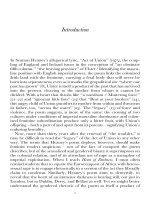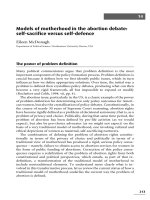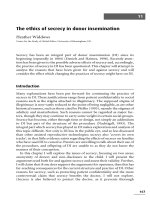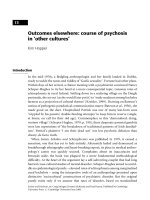Porin mediated transport of fluoroquinolones in mycobacterium tuberculosis
Bạn đang xem bản rút gọn của tài liệu. Xem và tải ngay bản đầy đủ của tài liệu tại đây (2.38 MB, 277 trang )
i
PORIN-MEDIATED TRANSPORT OF FLUOROQUINOLONES IN
MYCOBACTERIUM TUBERCULOSIS
JANSY PASSIFLORA SARATHY
B. Sc (Hons.), NUS
A THESIS SUBMITTED FOR THE DEGREE OF DOCTOR OF
PHILOSOPHY TO THE DEPARTMENT OF PHARMACOLOGY,
NATIONAL UNIVERSITY OF SINGAPORE
2013
ii
DECLARATION
I hereby declare that this thesis is my original work and it has been written by
me in its entirety. I have duly acknowledged all the sources of information
which have been used in the thesis.
This thesis has also not been submitted for any degree in any university
previously.
___________________________
Jansy Passiflora Sarathy
iii
ACKNOWLEDGEMENTS
The past four years have been like one long and crazy roller coaster ride. I look back in fondness
at the memories that I have created both in and out of the lab. I must first and foremost thank my
supervisors Dr. Veronique Dartois and Professor Edmund Lee. I have come to depend on
Veronique’s encouragement and unwavering faith in me and I look forward to working with her
in the future. I will always remember Prof. Lee’s kindness and compassion. I am grateful that I
crossed paths with him over five years ago as an honors student. I would also like to express my
appreciation to Martin Gengenbacher for mentoring me in my first year as a graduate student.
I would like to thank fellow students and staff of the Novartis Institute for Tropical Diseases for
their guidance and support. I have grown very fond of many of them and will miss them all
dearly as I move on to my next research position. I appreciate every word of advice and every
moment spared to teach and mentor. I would also like to thank all the past and present staff of the
Pharmacogenetics Laboratory at the NUS Yong Loo Lin School of Medicine.
I thank my parents for always encouraging me to pursue my education. Having my family and
RJ to go home to everyday has made the challenges so much more bearable. I am always grateful
for their love and support. I also appreciate my dearest friends for standing by me and helping
me keep my sanity. And last but not least, I owe my deepest gratitude to Matt Zimmerman for
his love and patience.
iv
Cover Page
Declaration Page……………………………………………………………………………
ii
Acknowledgements………………………………………………………………………….
iii
List of Contents…………………………………………………………………………
iv
List of Tables………………………………………………………………………………
x
List of Figures……………………………………………………………………………….
xii
List of Abbreviations……………………………………………………………………….
xv
List of Publications and Manuscripts……………………………………………………
xix
Disambiguation of Terminology…………………………………………………………
xx
Chapter 1. Literature Review and Study Objectives……………………………………
1
1.1 Tuberculosis: The Global Phenomenon………………………………………………….
2
1.2 Antituberculosis Chemotherapy………………………………………………………….
6
1.2.1 Fluoroquinolones………………………………………………………………
6
1.3 The Mycobacterial Outer Membrane…………………………………………………….
10
1.3.1 Passive Diffusion of Hydrophobic Molecules…………………………………
12
1.3.2 Active Efflux Processes……………………………………………………….
13
1.3.2.1 Influx Transporters………………………………………………
13
1.3.2.2 Efflux Pumps……………………………………………………
13
1.3.2.2.1 Natural Abundance……………………………………
13
1.3.2.2.2 Induction of expression………………………………
18
1.3.2.2.3 Efflux pump mutations…………………………………
20
1.3.3 Mycobacterial Porins…………………………………………………………
22
1.3.3.1 MspA of M. smegmatis
23
1.3.3.2 OmpATb of M. tuberculosis………………………………………
24
v
1.3.3.3 Other porins of M. tuberculosis……………………………………
25
1.3.3.4 Porin-mediated Drug Uptake……………………………………
26
1.3.3.5 Polyamines………………………………………………………
29
1.3.3.5.1 Biosynthesis and Excretion…………………………….
29
1.3.3.5.2 Functions……………………………………………….
32
1.3.3.5.3 Induction……………………………………………….
33
1.4 Phenotypic Drug Tolerance……………………………………………………………
34
1.4.1 The NRP State…………………………………………………………………
34
1.4.2 Cell Wall Thickening…………………………………………………………
36
1.4.3 Intracellular M. tuberculosis…………………………………………………
37
1.5 Specific Drug Accumulation in M. tuberculosis…………………………………………
39
1.6 Measuring Drug Uptake in Mycobacteria………………………………………………
45
1.6.1 M. bovis BCG as a model for the study of M. tuberculosis……………………
45
1.6.2 Experimental Methods for Quantification of Intracellular Drug Accumulation.
47
1.6.3 Experimental Methods for Lysis of Mycobacterial Cells……………………
48
1.7 Study Rationale…………………………………………………………………………
50
1.8 Study Objectives…………………………………………………………………………
54
Chapter 2. Development of a Drug Penetration Assay for Use on M. bovis BCG…….
57
2.1 Overview…………………………………………………………………………………
58
2.2 Materials and Methods…………………………………………………………………
60
2.2.1 Chemicals………………………………………………………………………
60
2.2.2 Strains and Culture Conditions………………………………………………
60
2.2.3 Drug Penetration Assay Development…………………………………………
61
2.2.3.1 Growth Kinetics…………………………………………………
61
vi
2.2.3.2 Evaluation of Cell Lysis Procedures………………………………
61
2.2.3.3 LC/MS/MS Quantitative Analysis………………………………
62
2.2.4 Assay Validation Methods……………………………………………………
68
2.2.4.1 Estimation of Matrix Effects……………………………………….
68
2.2.4.2 Spectrophotometric Detection of Cell Surface Adsorption………
68
2.2.4.3 Assessment of Accuracy and Precision of LC/MS Analysis………
69
2.2.5 Statistical Tests………………………………………………………………
69
2.3 Results……………………………………………………………………………………
70
2.3.1 Selection of Growth Phase of M. bovis BCG…………………………………
70
2.3.2 Assessment of the Efficiency of Various Lysis Procedures at Releasing
Intracellular Drug Content …………………………………………………….
71
2.3.2.1 Absolute Fluoroquinolone Recovery from Different Lysis
Procedures………………………………………………………….
71
2.3.2.2 Extent of Compound-loss During the Bead-beating Procedure……
72
2.3.3 Assessment of Assay Sensitivity……………………………………………….
74
2.2.3.1 Suppressive Effects of Lysozyme on Compound Detection……….
74
2.2.3.2 Quantitation Limits of Various Assays…………………………….
76
2.3.4 Fluorescence-detection of Cell-surface Absorbance of Fluoroquinolones…
77
2.3.5 Selection of a Fixed Time-point for the Measurement of Steady-state
Accumulation…………………………………………………………………
79
2.3.5.1 Time-course of Moxifloxacin Accumulation……………………
79
2.3.5.2 Maintenance of Cell Viability……………………………………
79
2.3.6 Intra- and Inter-day Variability………………………………………………
81
2.4 Discussion………………………………………………………………………………
82
Chapter 3. Characterization of Fluoroquinolone Uptake in M. bovis BCG……………
87
3.1 Overview…………………………………………………………………………………
88
vii
3.2 Materials and Methods…………………………………………………………………
90
3.2.1 Chemicals………………………………………………………………………
90
3.2.2 Drug Penetration Assay and Quantitative Analysis……………………………
90
3.2.3 Susceptibility Testing…………………………………………………………
93
3.2.4 In silico Profiling and Statistical Testing………………………………………
93
3.3 Results……………………………………………………………………………………
94
3.3.1 Kinetics of Fluoroquinolone Accumulation……………………………………
94
3.3.2 Intra-class Variability in Steady-state Concentrations………………………
98
3.3.3 Effects of External Concentration on Fluoroquinolone Accumulation………
104
3.3.4 Investigating Competitive Inhibition of Fluoroquinolone Accumulation……
108
3.3.5 Effects of Efflux Pump Inhibitors on Fluoroquinolone Accumulation………
110
3.3.6 Investigating the Dependence of Fluoroquinolone Accumulation and Activity
on Carboxyl-group Deprotonation……………………………………………
111
3.3.6.1 Effects of Medium pH on Fluoroquinolone Accumulation………
111
3.3.6.2 Effects of Medium pH on Fluoroquinolone Activity………………
111
3.4 Discussion………………………………………………………………………………
115
Chapter 4. Inhibition of Porin-mediated Fluoroquinolone Transport by polyamines
119
4.1 Overview…………………………………………………………………………………
120
4.2 Materials and Methods…………………………………………………………………
122
4.2.1 Chemicals………………………………………………………………………
122
4.2.2 Drug Penetration Assay and Quantitative Analysis……………………………
122
4.2.3 Susceptibility Testing………………………………………………………….
123
4.2.4 Generation of Spontaneous Mutants………………………………………….
123
4.2.5 Statistical Tests………………………………………………………………
124
4.2.6 Quantification of Cadaverine Production and Secretion………………………
124
viii
4.2.7 Sequence Alignment…………………………………………………………
125
4.3 Results……………………………………………………………………………………
126
4.3.1 Inhibitory Effects of Polyamines on Fluoroquinolone Accumulation…………
126
4.3.1.1 Potencies of Various Polyamines…………………………………
126
4.3.1.2 Effects of Spermidine on the Kinetics of Fluoroquinolone Uptake
130
4.3.1.3 Intra-class Variation in Response to Polyamine Treatment……….
130
4.3.2 Reversibility of Effects of Polyamines………………………………………
133
4.3.3 Effect of pH Changes on Polyamine Activity………………………………….
133
4.3.4 Effects of Spermidine on Mycobacteria Susceptibility to Ciprofloxacin……
135
4.3.5 Spontaneous Mutant Generation……………………………………………….
138
4.3.6 Cadaverine Production and Secretion………………………………………….
138
4.4 Discussion………………………………………………………………………………
139
Chapter 5. Understanding Fluoroquinolone Susceptibility and Uptake in Non-
replication M. tuberculosis
148
5.1 Overview…………………………………………………………………………………
149
5.2 Materials and Methods…………………………………………………………………
151
5.2.1 Culture Conditions…………………………………………………………….
151
5.2.2 Susceptibility Testing………………………………………………………….
151
5.2.3 Drug Penetration Assay and Quantitative Analysis……………………………
151
5.2.4 Calculation of Intracellular Concentration…………………………………….
152
5.2.5 Measurement of Cell Size Distribution………………………………………
153
5.2.6 Statistical Tests………………………………………………………………
153
5.3 Results……………………………………………………………………………………
154
5.3.1 Antibiotic Susceptibility……………………………………………………….
154
5.3.2 Accumulation of 10 Standard TB Drugs in Non-replicating M. tuberculosis
156
ix
5.3.3 Effect of Efflux Pump Inhibitors on Drug Accumulation in Non-replicating
Bacteria………………………………………………………………………
160
5.3.4 Kinetics of Drug Accumulation in Non-replicating Bacteria………………….
160
5.3.5 Polyamine Treatment of M. tuberculosis………………………………………
162
5.3.6 Measurement of Cell Size Distribution………………………………………
164
5.4 Discussion………………………………………………………………………………
165
Chapter 6. Understanding Porin Gene Expression in Non-replication M.
tuberculosis…………………………………………………………………….
171
6.1 Overview…………………………………………………………………………………
172
6.2 Materials and Methods…………………………………………………………………
174
6.2.1 Chemicals………………………………………………………………………
174
6.2.2 Analysis of Porin Protein Expression………………………………………….
174
6.2.2.1 Total RNA Extraction……………………………………………
174
6.2.2.2 cDNA Preparation………………………………………………….
175
6.2.2.3 Quantitative RT-PCR………………………………………………
176
6.2.3 Structural Predictions and Sequence Alignment……………………………….
179
6.3 Results……………………………………………………………………………………
180
6.3.1 RT-PCR Analysis of Porin Gene Expression in Replicating and Non-
replicating M. tuberculosis……………………………………………………
180
6.4 Discussion………………………………………………………………………………
185
Chapter 7. Conclusion……………………………………………………………………
191
7.1 Conclusion……………………………………………………………………………….
192
References…………………………………………………………………………………
198
Appendix I…………………………………………………………………………………
212
Appendix II…………………………………………………………………………………
217
Appendix III………………………………………………………………………………
249
x
List of Tables
No.
Title
Pg.
1
Summary of several known mycobacterial efflux pumps, their drug substrates and
their energy sources
16
2
Summary of specific drug transport activities of mycobacterial porins
28
3
Biophysical characteristics of OmpATb from M. tuberculosis and porins from
other selected bacterial species
28
4
Physico-chemical properties and intracellular accumulation factors of several
antibiotics in M. tuberculosis
42
5
Mass transitions monitored for each drug, elution times and lower limits of
quantitation
64
6
Gradient method for all fluoroquinolones tested in this study
65
7
Gradient method for rifampicin, rifabutin, thioridazine, linezolid
65
8
Gradient method for rifapentine
66
9
Gradient method for ethambutol
66
10
Gradient method for TMC207
67
11
Gradient method for para-aminosalicylic acid
67
12
LLOQs of moxifloxacin, rifabutin and mefloquine in different matrices for their
respective analytical methods
76
13
Intra- and inter-day variabilities of moxifloxacin analysis
81
14
The steady-state accumulation in M. bovis BCG, activities and physicochemical
properties of six fluoroquinolones
100
15
MIC
90
of ciprofloxacin, moxifloxacin and gatifloxacin against M. bovis BCG at
pH6.5 and pH5
114
16
The IC
50
s
of polyamines on the uptake of ciprofloxacin by M. bovis BCG
129
xi
17
The molecular weights, ClogP and Polar Surface Area (PSA) of four
fluoroquinolones and their spermidine-induced decreases in intracellular
accumulation
147
18
The bactericidal activity of 10 standard anti-tuberculous drugs on both
replicating and non-replicating M. tuberculosis
155
19
The intracellular concentrations of 10 anti-tuberculous agents in replicating and
non-replicating M. tuberculosis
159
20
Sequences of oligonucleotides used in this study
177
21
Results from qRT-PCR analysis of 10 genes of both actively-replicating and
non-replicating cultures of M. tuberculosis
182
xii
List of Figures
No.
Title
Pg.
1
Illustration of a classic tuberculous granuloma
5
2
Mechanisms of drug influx and efflux across the mycobacterial cell wall
5
3
The required pharmacophore of quinolones
9
4
The chemical structures of some common fluoroquinolones
9
5
Model for porin-mediated uptake through the mycobacterial cell envelope
23
6
Molecular structures of the four key polyamines
30
7
The biosynthetic pathway of putrescine, spermidine and spermine and
cadaverine
31
8
Correlations between intracellular drug accumulation factors and
physicochemical properties
43
9
Growth curve for M. bovis BCG
70
10
Moxifloxacin recovery from different cell lysis procedures
73
11
Comparison of signal strengths of moxifloxacin in different matrices
75
12
Fluorescence-detection of moxifloxacin in lysed fractions of M. bovis BCG
78
13
Kinetics of moxifloxacin accumulation in M. bovis BCG
80
14
Plot of the time-kill profile of 10µM of moxifloxacin against M. bovis BCG
79
15
Schematic diagram of the validated drug penetration assay
92
xiii
16
The kinetics of fluoroquinolone accumulation in M. bovis BCG
95
17
The steady-state accumulation of 6 fluoroquinolones in M. bovis BCG
101
18
Correlations between the intracellular accumulation of six fluoroquinolones and
their activities and physicochemical properties
102
19
The effect of exogenous drug concentration on the initial rate of fluoroquinolone
accumulation
105
20
Competitive inhibition of ciprofloxacin accumulation
109
21
The effects of efflux pump inhibitors on fluoroquinolone accumulation
110
22
The effects of acidic external pH on fluoroquinolone accumulation
112
23
MIC curve-shifts for fluoroquinolones as a result of increased medium acidity
113
24
A schematic diagram showing adduct-formations between TNBS and lysine /
cadaverine
124
25
Inhibition of ciprofloxacin accumulation in M. bovis BCG by treatment with
polyamines
127
26
Ciprofloxacin accumulation in M. bovis BCG in response to increasing
concentrations of polyamines
128
27
The effects of spermidine on the kinetics of CPX accumulation
131
28
Kill-kinetics of 10mM of spermidine against M. bovis BCG
131
29
The inhibitory effect spermidine has on the accumulation of fluoroquinolones
and non-fluoroquinolones
132
30
The effects of PBS washes on the inhibition of ciprofloxacin accumulation
134
31
The effects of increasing pH on the inhibitory effects of spermidine
134
32
MIC curves of spermidine and cadaverine against M. bovis BCG
136
xiv
33
MIC curves of ciprofloxacin against M. bovis BCG in the presence of
spermidine and cadaverine
136
34
Kill-kinetics of M. bovis BCG during a 5-days incubation period with
ciprofloxacin and spermidine
137
35
Multiple amino-acid sequence alignment of CadB orthologues
146
36
Intracellular accumulation of 10 anti-tuberculous agents in M. tuberculosis in
two different growth states
158
37
The effects reserpine and verapamil on intracellular ofloxacin accumulation in
replicating and non-replicating M. tuberculosis
161
38
The kinetics of ofloxacin accumulation in replicating and non-replicating M.
tuberculosis
161
39
The effects of spermidine on ciprofloxacin accumulation in replicating and non-
replicating M. tuberculosis
163
40
A size comparison between exponentially-replicating and non-replicating M.
tuberculosis
164
41
Four hypothetical mechanisms for drug resistance acquisition in persistent M.
tuberculosis via porin modifications
170
42
Expression levels of 10 OMP genes of M. tuberculosis following a shift to the
non-replicating state
184
43
Multiple amino-acid sequence alignment of Rv1698 orthologues
189
44
A graphic representation of the predicted transmembrane helices in Rv1698
190
xv
List of Abbreviations
(Listed in alphabetical order)
ABC ATP-binding cassette
ACN Acetonitrile
ADS Albumin-dextrose-saline
ATP Adenosine triphosphate
BCG Bacillus Calmette-Guérin
BSL3 Biosafety Level 3
CAD Cadaverine
CCCP Carbonyl cyanide m-chlorophenyl hydrazine
cDNA Complementary DNA
CFX Clinafloxacin
CFU Colony-forming Unit
CPX Ciprofloxacin
DNA Deoxyribonucleic acid
EDTA Ethylenediaminetetraacetic acid
EMB Ethambutol
GFX Gatifloxacin
HPLC High-performance liquid chromatography
IBC Institutional Biosafety Committee
xvi
IC/EC Intracellular concentration – Extracellular concentration ratio
INH Isoniazid
LCC Loebel cidal concentration
LC/MS Liquid chromatography coupled to Mass spectrometry
LLOQ Lower limit of quantification
LNZ Linezolid
LVX Levofloxacin
MATE Multi antimicrobial extrusion protein
MeOH Methanol
MDR Multi-drug resistant
MBC Minimum bactericidal concentration
ME Matrix Effects
MEF Mefloquine
MFS Major facilitator superfamily
MIC Minimum inhibitory concentration
MRM Multiple reaction monitoring
MTB Mycobacterium tuberculosis
MXF Moxifloxacin
NADH Nicotinamide adenine dinucleotide
NRP Non-replicating persistence
OADC Oleic acid albumin dextrose complex
xvii
OD Optical density
OFX Ofloxacin
OMP Outer membrane protein
PAS para-aminosalicylic acid
PBS Phosphate-buffered saline
PMF Proton motive force
PSA Polar surface area
RES Reserpine
RIB Rifabutin
RIF Rifampicin
RIP Rifapentine
RNA Ribonucleic acid
RND Resistance nodulation division
RT-PCR Reverse transcription polymerase chain reaction
SMR Small multidrug resistance
SPM Spermidine
SPX Sparfloxacin
SSC Steady-state concentration
TB Tuberculosis
TMC TMC207
TMS Transmembrane segment
xviii
TMHMM Transmembrane prediction using Hidden Markov Model
TNBS Trinitrobenzensulfonic acid
TRZ Thioridazine
VER Verapamil
XDR Extremely drug resistance
xix
List of Publications
1. Sarathy JP, Dartois V, Lee EJD. The Role of Transport Mechanisms in Mycobacterium
Tuberculosis Drug Resistance and Tolerance. Pharmaceuticals. 2012; 5(11):1210-1235.
2. Sarathy JP, Lee EJD, Dartois V. Polyamines inhibit fluoroquinolone uptake in
mycobacteria. PLoS One. 2013; 8(6): e65806.
3. Sarathy JP, Dartois V, Dick T, Gengenbacher M. Impaired drug uptake contributes to
phenotypic resistance in nutrient-starved non-replicating Mycobacterium tuberculosis.
Antimicrobial Agents and Chemotherapy. 2013; 57(4): 1648-53.
xx
Disambiguation of Terminology
In order to avoid confusion regarding the use of certain terminology in this thesis, some
definitions have been provided.
1. Drug uptake and Drug accumulation
Drug uptake refers to the specific process of movement of drugs from the extracellular
environment into the intracellular matrix, be it by passive or active mechanisms.
Drug accumulation refers to the built-up intracellular content of a drug. This
accumulation is the net effect of drug uptake, efflux and enzymatic conversion processes.
Steady –state drug accumulation refers specifically to the achievement of equilibrium
between drug uptake and efflux process such that an extension of the incubation period
does not result in a further increase in intracellular accumulation.
2. Diffusion and Facilitated diffusion
Diffusion is defined as the passive process of movement of molecules down a
concentration gradient, from a region of high concentration to a region of low
concentration of the compound.
Facilitated diffusion refers to the specific transport process where special transport
proteins (ie. carrier proteins and ion channels) assist molecules to transverse a biological
membrane. This is similar to passive diffusion in the way it does not require the spending
of metabolic energy.
xxi
3. Drug resistance and Phenotypic drug resistance
Drug resistance generally refers to decreased drug susceptibility that is brought about by
either genotypic or phenotypic changes.
Phenotypic drug resistance refers to the reversible phenomenon where decreased drug
susceptibility is not the result of genetic mutations. Such drug tolerance is mediated by
the physiological state of dormancy and full susceptibility is usually restored upon the
resumption of bacterial growth.
1
CHAPTER 1
LITERATURE REVIEW AND STUDY OJECTIVES
Parts of this project have been included in the following manuscript:
Sarathy JP, Dartois V, Lee EJD. The Role of Transport Mechanisms in Mycobacterium Tuberculosis
Drug Resistance and Tolerance. Pharmaceuticals. 2012; 5(11):1210-1235.
2
1.1 Tuberculosis: The Global Phenomenon
In 2009, it was estimated that there were 9.4 million incident cases of tuberculosis (TB)
infections and 1.7 million tuberculosis-related deaths worldwide (240). Despite the availability of
effective treatment options since the 1950s, and the implementation of well-structured treatment
programs, the TB epidemic is not being controlled. Frontline anti-tuberculous drugs have
gradually become ineffective because of the increasing incidence of resistance. Multidrug-
resistant TB (MDR-TB) is a difficult-to-treat form of M. tuberculosis that fails to respond to the
two most effective first-line anti-tuberculous drugs, rifampicin and isoniazid. The World Health
Organization (WHO) estimated that in 2009, around 5% of all new tuberculosis cases of
infections involved MDR-TB (241). Strains that combine MDR with additional resistance to
fluoroquinolones and at least one injectable drug have been appropriately named extensively
drug-resistant tuberculosis (XDR-TB). The burden of tuberculosis on global health has pushed
the research community into focusing efforts on the development of new vaccines, diagnostics
and chemotherapy against Mycobacterium tuberculosis, the causative agent.
The TB pathology is diverse, generating different types of lesions, containing several micro-
environments each harboring metabolically distinct bacterial sub-populations, some of which are
not effectively killed by most existing drugs (148). This drug tolerance phenomenon typical of
tuberculosis has been coined ‘phenotypic drug resistance’ (198), and is partly attributed to the
pathogen’s ability to remain sequestered in macrophages and other stress-inducing micro-
environments in a non-replicating state of persistence (Figure 1) (42). These dormant bacilli are
primarily responsible for the persistent and latent forms of the disease, but retain the potential to
resume growth and produce an active infection, making them a critical target population of
antimycobacterial agents (42, 238, 239).
3
The development of new antimycobacterials active against dormant cells and resistant strains is
in need of novel drug targets. The failure of existing chemotherapeutic options to control the TB
epidemic can be attributed in part to sub-therapeutic concentrations at the site of action (113).
The longer a pool of bacteria is exposed to sub-inhibitory levels of an antimicrobial agent, the
more likely the emergence and selection of resistant clones becomes (49). This has prompted
researchers and drug discovery experts to turn to strategies which would potentiate existing
therapeutics by increasing their intracellular levels through the use of small molecule inhibitors
against efflux pumps (129).
The cell envelope of mycobacteria is notorious for being several-fold less permeable to
chemotherapeutic agents when compared to functionally similar cell walls of other bacteria (105).
The knowledge of drug transport pathways could assist in the successful design of novel
chemotherapeutic combinations against M. tuberculosis. Figure 2 illustrates the various transport
processes that take place across the mycobacterial outer membrane. In this introduction section,
we review the current understanding of the various influx and efflux pathways in mycobacteria
while focusing our attention on details specific to M. tuberculosis. The function and expression
of transport proteins such as porins, drug importers and efflux pumps are summarized and their
respective influence on the drug-resistant and non-replicating persistent states is highlighted.
Collectively, the literature data compiled here show that M. tuberculosis and other mycobacteria
have evolved several intrinsic and adaptive mechanisms to increase their level of tolerance
towards xenobiotic substances, by preventing or minimizing their entry: (i) natural or intrinsic
resistance mediated by the thickened highly hydrophobic and waxy envelope; (ii) reduced
permeability resulting from physiological adaptations under unfavorable environmental
conditions; (iii) drug-induced resistance acquired via increased expression of various classes of
4
efflux pumps; and (iv) genetically encoded resistance conferred by mutations in efflux
complexes.









